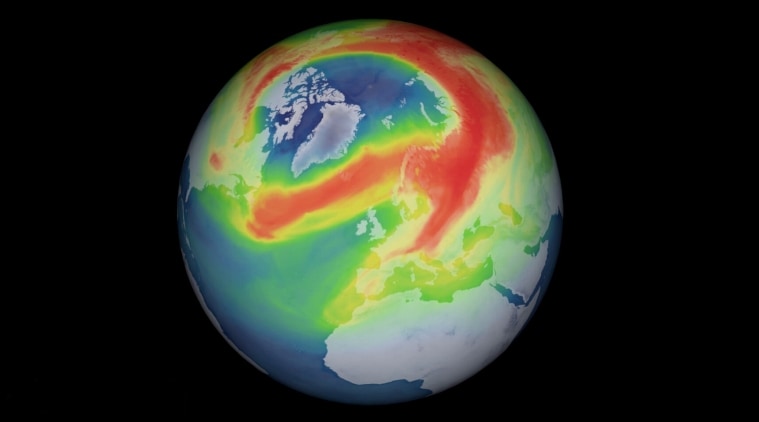Largest hole in the ozone layer over Arctic is now closed: Here’s what happened
Scientists believe the closing of the hole is because of a polar vortex, and not because of the lower pollution levels during the coronavirus lockdown.
 Scientists had spotted an unusual hole in the ozone layer over the Arctic. (Image source: Copernicus data (2020) processed by DLR/BIRA/ESA)
Scientists had spotted an unusual hole in the ozone layer over the Arctic. (Image source: Copernicus data (2020) processed by DLR/BIRA/ESA)
Earlier this month, scientists reported a sharp drop in ozone concentrations over the Arctic, believed to have been caused by unusual atmospheric conditions. The hole — first identified in March 2020 — has now closed.
Also Read | Explained: How the ozone layer hole over Arctic closed
The Copernicus Climate Change Service (C3S) and Copernicus Atmosphere Monitoring Service (CAMS), by the European Centre for Medium-Range Weather Forecasts (ECMWF), confirmed that the largest hole in the Ozone layer above the Arctic had closed.
“The unprecedented 2020 northern hemisphere #OzoneHole has come to an end. The #PolarVortex split, allowing #ozone-rich air into the Arctic, closely matching last week’s forecast from the #CopernicusAtmosphere Monitoring Service,” the official Twitter handle of Copernicus ECMWF tweeted.
Also read | Explained: What to read in ozone hole size
The ozone layer is a protective layer of gas in the stratosphere. It shields the planet from the sun’s harmful ultraviolet radiation, which can cause skin cancer and cataracts, apart from harming the environment.
The unprecedented 2020 northern hemisphere #OzoneHole has come to an end. The #PolarVortex split, allowing #ozone-rich air into the Arctic, closely matching last week’s forecast from the #CopernicusAtmosphere Monitoring Service.
More on the NH Ozone hole➡️https://t.co/Nf6AfjaYRi pic.twitter.com/qVPu70ycn4
— Copernicus ECMWF (@CopernicusECMWF) April 23, 2020
Scientists noticed the unusually strong depletion of ozone — believed to be the largest such hole over the northern polar regions — in March. The hole could have led to a bigger threat had it moved towards the south.
Although mini ozone holes over the North Pole aren’t rare, the depletion over the Arctic this year was much larger. The reason for this is said to be the polar vortex — a circling whirlpool of stratospheric winds responsible for bringing cold air to polar regions.
Express Tech is now on Telegram. Click here to join our channel (@expresstechnology) and stay updated with the latest tech news
Scientists also believe that the closing of the hole is because of the same polar vortex and not because of the lower pollution levels amid the coronavirus lockdown.







